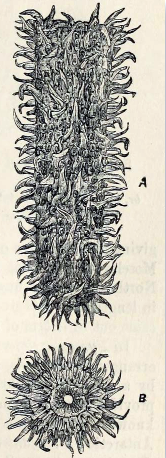Fire rollers
| Fire rollers | ||||||||||||
|---|---|---|---|---|---|---|---|---|---|---|---|---|

A small colony of fire rollers near Atauro , East Timor . |
||||||||||||
| Systematics | ||||||||||||
|
||||||||||||
| Scientific name of the family | ||||||||||||
| Pyrosomatidae | ||||||||||||
| Lahille , 1888 | ||||||||||||
| Scientific name of the genus | ||||||||||||
| Pyrosoma | ||||||||||||
| Péron , 1804 |
The fire rollers ( Pyrosoma ) are a genus of the salps (Thaliacea) from the class of tunicates (Tunicata). They live pelagically in colonies in the sea , which can consist of several thousand individual animals. The fire roller Pyrosoma atlanticum also lives in the Mediterranean and can penetrate into the North Sea .
features
The colonies have the shape of a bell or a thick-walled cylinder that is closed on one side. They usually reach a length of 15 to 20 centimeters with a diameter of three to four centimeters. The largest species Pyrosoma spinosum can be up to 12 meters long in exceptional cases. Such large colonies have been found in the Indian Ocean . In the Atlantic and Pacific , the colonies of this species reach a length of about one meter with a diameter of ten centimeters.
The outer surface of the animal colony is covered with villi-like outgrowths, between which there are many small inflow openings. Each inflow opening belongs to one of the individual animals embedded in the gelatinous mantle wall, which are on average four to five millimeters in size and have the typical characteristics of the tunicates. The ventral side of the individual animals points in the direction of the closed tip of the colony, the cloaca opening into the common cavity of the colony. The size of the open end of the cloacal cavity can be regulated by muscles.
Locomotion
The animal colony can actively move about by the individual animals closing their inlet openings and the water in the inner cavity of the colony being expelled by the contraction of the mantle. For this purpose, the mantle is traversed by long strands of mantle fibers formed from spindle-shaped muscle cells, which connect the cloacal muscles on both sides of the cloacal cavity of the individual animals. Otherwise the coat consists of nitrogenous compounds such as chondroitin and small amounts of cellulose . Most of the time, however, the fire rollers let themselves be driven by the ocean currents.
Reproduction
Like all salps, fire rollers go through a generation change during reproduction . After a gender generation, an asex generation follows. Each individual animal produces only one single egg cell in the course of its life, which is fertilized in the ovary by the sperm penetrating the fallopian tubes. The growing embryo bulges the wall to the cloacal cavity and finally breaks through into the cloaca. Here an asexual, jar-shaped oozoid (foster animal) emerges from it, which by budding produces four blastozoids. The contiguous blastozoids, now called primary ascidiozoids, are eventually expelled. Secondary ascidiozoids then form through budding and a new fire roller grows.
Bioluminescence
Fire rollers are one of the causes of sea glow . The bioluminescence is from bacteria of the genus Photobacterium causes the symbiotic live in the cells of the fire rolls. Because of their ability to bioluminesce, the fire rollers were discovered in 1804 by the French naturalist François Péron . He described the glow of the sea as a broad band of phosphorus that floated on the moving waves.
Mass volume
In the summer of 2017, there was a mass of previously unknown fire rollers off the west coast of the United States , the cause of which is still unclear.
literature
- K. Deckert, Gisela Deckert , GE Freytag, G. Peters, G. Sterba: Urania animal kingdom, fish, amphibians, reptiles. Urania-Verlag, 1991, ISBN 3-332-00376-3 .
Web links
- Integrated Taxonomic Information System Pyrosoma Péron, 1804
Individual evidence
- ↑ nytimes.com : Fiery Bodies Under the Waves (July 29, 2017)
- ↑ Spektrum.de , July 3, 2017: Invasion of the fire rollers (July 29, 2017)
- ↑ nationalgeographic.de , July 4, 2017: Huge masses of strange, glowing animals flood the Pacific (July 29, 2017)

